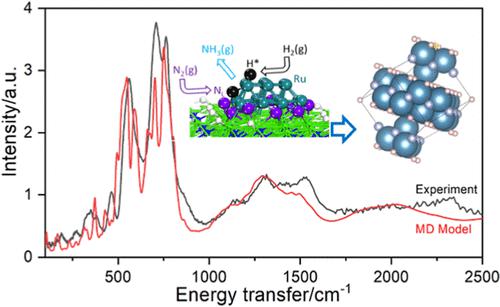当前位置:
X-MOL 学术
›
Chem. Mater.
›
论文详情
Our official English website, www.x-mol.net, welcomes your
feedback! (Note: you will need to create a separate account there.)
In Situ Neutron Scattering Study of the Structure Dynamics of the Ru/Ca2N:e– Catalyst in Ammonia Synthesis
Chemistry of Materials ( IF 7.2 ) Pub Date : 2023-03-06 , DOI: 10.1021/acs.chemmater.2c03599 Xinbin Yu 1, 2 , Jisue Moon 1, 2 , Yongqiang Cheng 3 , Luke Daemen 3 , Jue Liu 3 , Sung Wng Kim 4 , Abinash Kumar 2 , Miaofang Chi 2 , Victor Fung 2 , Anibal J. Ramirez-Cuesta 3 , Zili Wu 1, 2
Chemistry of Materials ( IF 7.2 ) Pub Date : 2023-03-06 , DOI: 10.1021/acs.chemmater.2c03599 Xinbin Yu 1, 2 , Jisue Moon 1, 2 , Yongqiang Cheng 3 , Luke Daemen 3 , Jue Liu 3 , Sung Wng Kim 4 , Abinash Kumar 2 , Miaofang Chi 2 , Victor Fung 2 , Anibal J. Ramirez-Cuesta 3 , Zili Wu 1, 2
Affiliation

|
NH3 synthesis is one of the most critical industrial processes. Compared to commercial iron catalysts, Ru catalysts show high intrinsic activity in this reaction but suffer from hydrogen poisoning. By loading Ru onto supports such as electrides and hydrides, the hydrogen poisoning problem can be significantly alleviated. However, relevant studies on the structural dynamics of the Ru/electride catalysts under reaction conditions are very scarce. Taking advantage of the high sensitivity to hydrogen species, it is possible to obtain insights into the structural changes during the reaction using in situ neutron techniques. In this study, we have investigated the structural evolution of the Ru/Ca2N:e– catalyst during the ammonia synthesis reaction by in situ neutron scattering (inelastic neutron scattering, INS) technique. In situ INS experiments suggest that Ca2N:e– is likely converted to the Ca2NH phase during the reaction. Unlike the previously known structure where H and N atoms are intermixed, the formed Ca2NH exhibits a segregated structure where the H and N atoms are located in different layers separated by the Ca layer. Density functional theory calculations of the reaction energetics reveal that there are minor changes in the barriers and thermodynamics of the first N hydrogenation step between the two phases (Ca2NH phase with segregated H/N layers and intermixed Ca2NH phase), suggesting the impact of the phases on the reaction kinetics to be relatively minimal.
中文翻译:

Ru/Ca2N:e– 氨合成催化剂结构动力学的原位中子散射研究
NH 3合成是最关键的工业过程之一。与商业铁催化剂相比,Ru 催化剂在该反应中表现出高本征活性,但会发生氢中毒。通过将 Ru 负载到电子化物和氢化物等载体上,可以显着缓解氢中毒问题。然而,关于反应条件下Ru/电子催化剂的结构动力学的相关研究非常缺乏。利用对氢物种的高灵敏度,可以使用原位中子技术深入了解反应过程中的结构变化。在这项研究中,我们研究了 Ru/Ca 2 N:e –的结构演变原位中子散射(inelastic neutron scattering,INS)技术氨合成反应过程中的催化剂。原位 INS 实验表明,Ca 2 N:e –可能在反应过程中转化为 Ca 2 NH 相。与先前已知的 H 和 N 原子混合的结构不同,形成的 Ca 2 NH 表现出分离结构,其中 H 和 N 原子位于由 Ca 层分隔的不同层中。反应能量学的密度泛函理论计算表明,在两相(Ca 2 NH 相,具有分离的 H/N 层和混合的 Ca 2NH 相),表明相对反应动力学的影响相对较小。
更新日期:2023-03-06
中文翻译:

Ru/Ca2N:e– 氨合成催化剂结构动力学的原位中子散射研究
NH 3合成是最关键的工业过程之一。与商业铁催化剂相比,Ru 催化剂在该反应中表现出高本征活性,但会发生氢中毒。通过将 Ru 负载到电子化物和氢化物等载体上,可以显着缓解氢中毒问题。然而,关于反应条件下Ru/电子催化剂的结构动力学的相关研究非常缺乏。利用对氢物种的高灵敏度,可以使用原位中子技术深入了解反应过程中的结构变化。在这项研究中,我们研究了 Ru/Ca 2 N:e –的结构演变原位中子散射(inelastic neutron scattering,INS)技术氨合成反应过程中的催化剂。原位 INS 实验表明,Ca 2 N:e –可能在反应过程中转化为 Ca 2 NH 相。与先前已知的 H 和 N 原子混合的结构不同,形成的 Ca 2 NH 表现出分离结构,其中 H 和 N 原子位于由 Ca 层分隔的不同层中。反应能量学的密度泛函理论计算表明,在两相(Ca 2 NH 相,具有分离的 H/N 层和混合的 Ca 2NH 相),表明相对反应动力学的影响相对较小。


















































 京公网安备 11010802027423号
京公网安备 11010802027423号